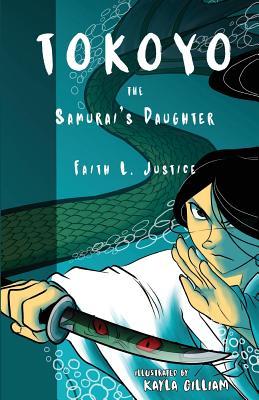 Tokoyo, The Samurai's Daughter by Faith L. Justice
Tokoyo, The Samurai's Daughter by Faith L. JusticeIllustrated by: Kayla Gilliam
Publisher: Raggedy Moon Books
Format: Paperback
Number of Pages: 111
Published: May 28th, 2017
Source: In exchange for an honest review, a review copy was received from the publisher.
Opening Lines: "I put the last oyster in the net bag attached to my belt and clasped my knife between my teeth. "
Tokoyo is the daughter of a samurai in medieval Japan during the fourteenth-century. When her father is falsely accused of cursing the local Regent Hojo Takatoki and banished to the Oki Islands far away, Tokoyo is determined to find and clear his name.
The story begins with Tokoyo coming up from a long dive of collecting oysters with the Ama, "women of the sea" or pearl divers. Among her catch is a pearl of "great worth," which she gifts to the Ama to thank them for allowing her to dive and training her. Later in the story, this generosity is repaid when the Ama take her in after her father is arrested and their home and wealth are seized. In addition, a corrupt minister claims all of Tokoyo's belongings except for some clothing and a knife she was able to barter for by giving him some of her deceased mother's jewelry. Several months go by as Tokoyo lives and works with the Ama collecting oysters, her father always on her mind. When her concerns about not receiving any word about his safety become too deep, Tokoyo sets out across the ocean traveling from village to village in the nearby islands searching for her beloved father. Everyone she meets has either not seen him or is unwilling to risk angering the Regent by telling her his whereabouts. While on one of the islands, Tokoyo comes across a priest about to sacrifice a young girl to appease the sea demons and she offers to take the girls place instead. Tokoyo plans to dive into the ocean and kill the sea demon or die trying.
According to the author's note, Tokoyo was inspired by a Japanese folktale called "The Tale of the Oki Islands" from the book, Best-Loved Folktales of the World. The story held a special meaning to the author so she was inspired to trace the origin of the original story, which it turns out was a collection of stories from Ancient Tales and Folk-lore from Japan written by Richard Gordon Smith. Also according to the authors note, the original story featured Tokoyo's father as the "hero" of the story but the author instead wanted to write a story about an adventurous girl who battles a sea demon to save her father. Tokoyo is both strong-willed and talented having learned how to dive and through her samurai training from her father. Just by looking at the cover you can see the determination in her eyes. She is also quite brave and a lovely heroine and the one who ultimately wields her dagger killing the sea demon. Tokoyo also manages to free her father by finding the actual culprit that cursed the Regent, thus winning his freedom. There are lovely black and white illustrations by Kayla Gilliam and I especially enjoyed the addition of the Cultural notes which provided the definition of the Japanese words used in the story as well as the Author's note at the end of the book. While the story had the length and feel of a folktale, I did wish the ending wouldn't have been so sudden as I really liked Tokoyo's spirit and love for her father and would've enjoyed learning more about her.
*Tokoyo, The Samurai's Daughter has been nominated for the Cybils award and my review reflects my personal opinion, not the opinion of the Cybils committee.*
Oh this sounds awesome! I'll have to keep an eye out for it!
ReplyDeleteSounds like a great story and would be interesting to read about Tokoyo's travels around Japan. I like the first line too, something I' pay attention to as a writer.
ReplyDeleteThis sounds interesting. I don't recall hearing of it before- so thank you for the introduction!
ReplyDelete~Jess
I love folktales. There's a reason folktales have been around so long.
ReplyDelete